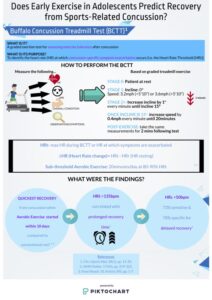Key words: concussion, sport, rehabilitation
Interest in sports-related concussion (SRC) has never been higher as potential longer-term effects of multiple brain injuries have become apparent, leading to sporting organisations making necessary changes to optimise player welfare. Protocols have been introduced that teams must comply with when a player is diagnosed with concussion, delaying their availability for selection. Treatment accelerating recovery in a safe manner is hence of interest.
What is sports-related concussion?
“Sports-related concussion (SRC) is a traumatic brain injury defined as a complex pathophysiological process affecting the brain, induced by biomechanical forces with several common features that help define its nature” (1).
The Buffalo Concussion Treadmill Test (BCTT)
The BCTT (2) establishes appropriate exercise levels to avoid triggering symptoms post SRC, in order to create tailored programmes that aid Return To Play (RTP). Athletes identify any new or worsening symptoms of concussion, with each assigned a value of 1 point on the Visual Analogue Scale (VAS). The athlete’s rate of perceived exhaustion (RPE) is recorded on a scale of 6 (no exertion) to 20 (unachievable maximum). The test is conducted on a treadmill using a consistent pace with the elevation increased one level every minute to increase intensity. Once the treadmill reaches maximum incline (15°), speed is increased by 0.4mph each minute in lieu. Measurements of heart rate (HR), VAS and RPE are taken every minute. The test is terminated when VAS increases by 3, with the HR at this point being the heart rate threshold (HRt). The test derives an athlete specific safe level of exercise at 90% of HRt.
Are there benefits to using the BCTT?
Leddy et al suggest that RTP is quicker from SRC in adolescents when sub-threshold aerobic exercise is started within 10 days of the injury compared to the conventional rest period (3). This was supported by an enhanced RCT, employing a larger sample with more diverse injury seriousness (4). Athletes assigned to a sub-threshold aerobic group were more likely to recover within 4 weeks of injury compared to a stretching group. Further, BCTT is a reliable indicator of those likely to suffer a prolonged recovery with post-concussive symptoms: HRt<135bpm (5) and/or difference between resting HR and HRt <50bpm (6). Sub-threshold aerobic exercise treatment within 10 days of injury significantly reduces the incidence of delayed recovery in adolescent athletes; this is important as persistent post-concussive symptoms has been linked to a reduced quality of life (4).
In summary, application of sub-threshold aerobic exercise programmes for adolescents, calculated by the BCTT, will allow for early active management of SRC. This allows for an evidence-based method for quicker RTP and discussion for change to the current concussion guidelines.

References
- McCrory P, Feddermann-Demont N, Dvořák J, Cassidy JD, McIntosh A, VOS PE et al. 2017. What is the definition of sports-related concussion: a systematic review. British Journal of Sports Medicine. 51, pp. 877-887.
- Leddy JJ, Haider MN, Willer BS. Buffalo Concussion 2020. Treadmill Test (BCTT) – Instruction Manual (Online). (Date Accessed 11 Nov 2021). Available from: https://cdn-links.lww.com/permalink/jsm/a/jsm_2020_01_28_haider_19-313_sdc1.pdf
- Leddy JJ, Haider MN, Ellis MJ, Mannix R, Darling SR, Freitas MS et al. Early Subthreshold Aerobic Exercise for Sport-Related Concussion: A Randomized Clinical Trial. JAMA Pediatr. 2018; 173(4), pp. 319-325.
- Leddy JJ, Master C, Mannix R, Weibe D, Grady M, Meehan W et al. Early targeted heart rate aerobic exercise versus placebo stretching for sport-related concussion in adolescents: a randomised controlled trial. Lancet child adolesc health 2021; 5: 792-99.
- Leddy JJ, Hinds AL, Miecznikowski J, Darling S, Matuszak J, Baker JG et al. Safety and Prognostic Utility of Provocative Exercise Testing in Acutely Concussed Adolescents: A Randomized Trial. Clin J Sports Med. 2018; 28(1), pp. 13-20.
- Haider MN, Leddy JJ, Wilber CG, Viera KB, Becherano I, Wilkins KJ et al. The Predictive Capacity of the Buffalo Concussion Treadmill Test After Sport-Related Concussion in Adolescents. Front Neurol. 2019; 10: 395, pp. 1-7
Authors
1. Andrew Shafik
2. Hannah Girdlestone
3. Daire Rooney
Author affiliation
1. Millwall Football Club Medical Department, London, UK
2. Basildon and Thurrock University Hospitals NHS Foundation Trust, Basildon, UK
3. Queen’s University Belfast, School of Medicine, Belfast, UK
Competing interests
There are no competing interests for any author.